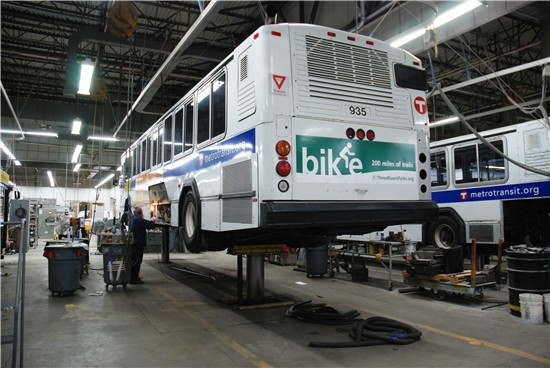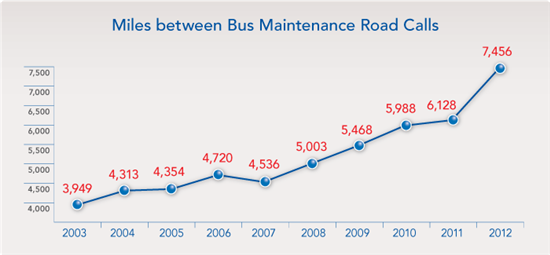 Judging strictly by appearances, the 1984 Ford tow truck kept at the Martin J. Ruter Garage in Brooklyn Center may not seem particularly noteworthy.
Judging strictly by appearances, the 1984 Ford tow truck kept at the Martin J. Ruter Garage in Brooklyn Center may not seem particularly noteworthy.
But the truck has a distinct honor: it is the oldest vehicle in Metro Transit’s fleet. After nearly three decades in service, it has logged just 35,000 miles retrieving broken down buses or vehicles caught in winter storms.
The truck’s longevity is more than a piece of trivia, however. The extended life is a testament to how well Metro Transit’s buses perform on a daily basis.
In 2012, Metro Transit buses collectively traveled an average of nearly 7,500 miles between calls for roadside service, peaking in October with an agency record of 8,293 miles between road calls. The “miles between maintenance” measurement is calculated by dividing the total number of miles traveled among all buses by the number of maintenance-related roadcalls.
Last year's performance marks an 89 percent improvement from a decade earlier. Such improvements don't just happen, though. A group of nearly 300 specially-trained mechanics work around the clock at Metro Transit’s five garages and the St. Paul Overhaul Base to keep buses in top condition.
Buses are regularly inspected to ensure all systems are functioning correctly and that any concerns that are identified are quickly addressed before a bus goes back on the road.
In addition to being vigilant, maintenance staff use operator feedback to better understand how vehicles are performing on the road and have built relationships with industry suppliers so that Metro Transit gets the best buses it can.
Better transmissions and other components have not only made buses more dependable and improved engine life, but improved fuel efficiency and overall comfort for customers. Metro Transit’s persistence on quality and reliability has also led to product improvements that have been incorporated into the bus builder’s product line – providing a better, more reliable product not just for Metro Transit customers but all transit users.
“There’s a continual drive to improve each year,” said Rob Milleson, Metro Transit’s director of bus maintenance. “We’re constantly monitoring and constantly learning.”
The combination of high-quality maintenance and procurement helps keep Metro Transit buses in service at least 12 years before they are put into service for the Minnesota State Fair or put up for public auction.
Most buses in Metro Transit’s fleet log an average of 410,000 miles before being replaced. By comparison, the average car lasts 11 years and 165,000 miles.
 Milleson said that performance record is particularly impressive considering all of the challenges – most notably Minnesota’s harsh winters – that buses face as they transport customers throughout the year.
Milleson said that performance record is particularly impressive considering all of the challenges – most notably Minnesota’s harsh winters – that buses face as they transport customers throughout the year.
The credit, he says, goes to those who spend their days making sure buses perform at their peak.
“While a combination of factors impact reliability and bus longevity it’s our front line employees that really make it all come together,” Milleson said.
> New buses hit the streets
> Fact Book tells Metro Transit's story by the numbers